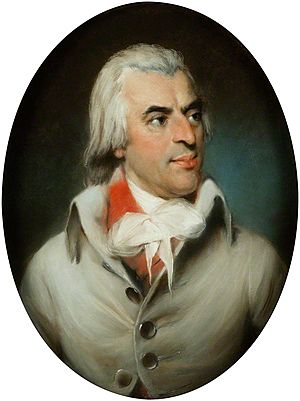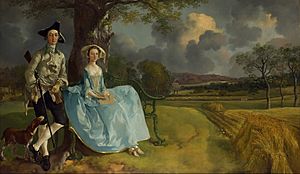Arthur Young (agriculturist) facts for kids
Quick facts for kids
Arthur Young
|
|
|---|---|

Arthur Young, by John Russell, 1794
|
|
| Born | 11 September 1741 Whitehall, London
|
| Died | 12 April 1820 (aged 78) Sackville Street, London
|
| Occupation | Writer on agriculture, economics, and social statistics |
Arthur Young (born September 11, 1741 – died April 12, 1820) was an English writer and expert on farming. Even though he wasn't a very successful farmer himself, he became famous as an expert on how to improve farming methods. He wrote many books and articles about agriculture, economics, and society.
Young is best known for his detailed observations about social and political life. His books, like Tour in Ireland (1780) and Travels in France (1792), were read by many people. After the French Revolution in 1789, his opinions on politics were important because he had seen what was happening. He became a strong voice against some British reformers.
Contents
Early Life and First Steps
Arthur Young was born in 1741 in Whitehall, London. His father was a church leader in Suffolk. Arthur went to school in Lavenham and later worked for a trading company.
When his father passed away in 1759, Young took charge of his family's small estate, Bradfield Hall. It had some debts, but he focused on farming there from 1763 to 1766. In 1762, he also started a magazine called The Universal Museum.
Young met and became friends with Walter Harte, another writer, who encouraged him to focus on writing about farming. Young studied the works of other famous agriculturists and contributed to a magazine called Museum Rusticum.
Becoming a Farmer and Writer
In 1767, Young started a farm in Essex. Later, he moved to another farm in Hertfordshire. There, he tried many farming experiments. Even though these experiments didn't always work out, they taught him a lot about agriculture.
From 1773, he also worked as a reporter for a London newspaper, covering what happened in Parliament.

In 1774, Young became a member of the Fellow of the Royal Society, a famous group for scientists. In 1784, he started his own publication called the Annals of Agriculture. This magazine ran for 45 volumes! Even King George III (who ruled at the time) wrote articles for it using a fake name.
In 1793, Young was chosen to be the secretary of the Board of Agriculture. This group was set up to gather information about farming across England. He helped collect and prepare surveys about agriculture in different counties.
Travels and Observations
Young loved to travel and write about what he saw. He went on many journeys through England and Wales, describing them in books published between 1768 and 1770. These books included A Six Weeks' Tour through the Southern Counties of England and Wales and A Six Months' Tour through the North of England. He said his books were the only ones that gave real, firsthand information about farms and their produce in England. His books were very popular and were translated into other languages.
He also traveled to Kingdom of Ireland in 1776–1777 and wrote Tour in Ireland, which was published in 1780.
Young's most famous travels were to France. He visited France every year from 1787 to 1789, right when the French Revolution was starting. He wrote about the lives of ordinary people and how public affairs were handled during this important time. His book Travels in France came out in 1792.
Views on the French Revolution
Arthur Young was in France during the fall of the Bastille in 1789, a key moment in the French Revolution. He was even welcomed by some of the highest French nobles, including the King and Queen.
However, by 1792, he became very concerned about the violence of the Revolution. He saw burned castles and chaotic debates, which shocked him. He changed his mind about some of his earlier ideas for political change in England. Young became a supporter of Edmund Burke's views, which warned against the dangers of the Revolution. He wrote a pamphlet called Plain and Earnest Address to Britons in 1792, encouraging British people to be loyal.
In 1793, Young helped create the Suffolk Yeomanry, a group of volunteer cavalry soldiers, to help keep order. He also wrote Example of France a Warning to Britain, warning Britain about the dangers of following France's path.
Friends and Connections
Young had many important friends and connections. His closest friend was John Symonds, a university professor. They often worked together on Young's writings.
Young also knew Sir Joseph Banks, a famous scientist. They worked together to oppose rules that limited the export of wool. Young believed that restricting wool exports hurt landowners.
When Young traveled, he often met with important farmers and people who wanted to improve agriculture. These meetings helped him gather information for his books.
Later Life and Legacy
From 1801, Young became very religious, following the teachings of Thomas Scott. In 1811, he became good friends with Marianne Francis, who shared his strong religious beliefs. Sadly, his eyesight began to fail, and an operation for a cataract left him blind.
Young continued to publish pamphlets even after losing his sight. He passed away in London on April 12, 1820, at the age of 78. He was buried at Bradfield Combust church. His tomb has a special message: "Let every real patriot shed a tear, For genius, talent, worth, lie buried here."
Arthur Young had a big impact on people who studied economics and society, like Frederick Morton Eden. He also influenced American farmers who wanted to improve their methods.
More recently, people have studied Young for his ways of gathering information. Some see him as a pioneer in collecting national income statistics. Others believe he was one of the first to use sample surveys, which means collecting information from a small group to understand a larger one.
Works
Arthur Young became famous for his ideas as an agricultural improver, an economist, and someone who observed society. When he was just 17, he wrote a pamphlet about a war in North America. He also wrote several early novels.
Some of his important works include:
- The Farmer’s Letters to the People of England, 1768.
- The Farmer’s Calendar, 1771. This book was reprinted many times.
- Political Arithmetic, 1774. This book was translated into many languages.
- A Tour in Ireland, 1780.
- Annals of Agriculture and other useful Arts, 1785-1809.
- Travels during the years 1787, 1788, & 1789 : undertaken more particularly with a view of ascertaining the cultivation, wealth, resources, and national prosperity of the Kingdom of France, 1792.
- View of the agriculture of Oxfordshire, 1809.
His Travels in France was translated into French. In 1801, the French government even ordered his writings to be translated into 20 volumes under the title Le Cultivateur anglais (The English Farmer).
Family Life
In 1765, Arthur Young married Martha Allen. Their marriage was often difficult. Young deeply loved his children. He was heartbroken when his daughter Martha Ann died from tuberculosis at the age of 14 in 1797. Her death is said to have made him turn more towards religion.
Images for kids




